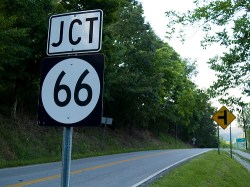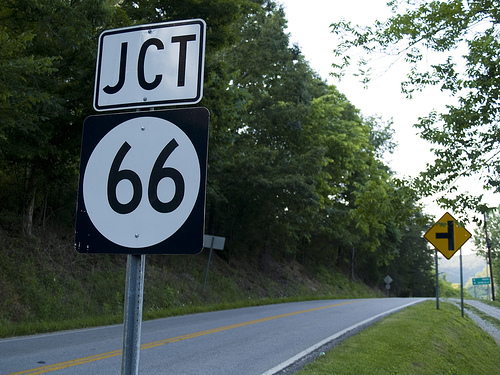
Photo by James Thompson.
Congress normally revisits funding for transportation projects every several years, reevaluating spending, priority projects, and the like. That’s what they normally do. The current transportation legislation was passed in 2005 and repeatedly extended until revisiting the entire bill became impossible to avoid. In other words, until now. The most recent extension ends Saturday.
In March, the Senate passed a transportation reauthorization bill called Moving Ahead for Progress in the 21st Century, clearing the normally contentious chamber by a nearly 3-to-1 vote. MAP-21 [PDF], as it’s lovingly called, is by most accounts a strong compromise, a two-year bill that includes a variety of new and revised programs that address maintenance, new road creation, transit, and beautification. Is it what many of us would want to see if we were given the government’s pocketbook? No. But it could be worse.
It could, for example, be the House’s version. The House has yet to pass full reauthorization legislation, instead signing off on short-term extensions. Recognizing the urgency and need of infrastructure investments, the House has decided to play its normal game: load the bill up with unrelated crap and negotiate to get the bill as far to the right as possible. Included in the House’s proposals are an effort to halt EPA regulations on coal ash (here’s EarthJustice on the issue) and to force authorization of the full Keystone pipeline. The former is at least sort of transportation-related; coal ash is a common component of concrete. The latter is the political equivalent of crossing your arms and holding your breath until you turn blue.
There have been ongoing rumors over the course of the week that a compromise between the two chambers would be reached. If anything other than a short-term extension is going to happen, a bill needs to be finalized and submitted by midnight tonight. Within the past few hours, in fact, there have been reports of a deal being reached. As of writing, that hasn’t been confirmed.
In politics, a short timeline favors those most willing to dig in their heels. In this scenario, as in so much of modern politics, that means the Republicans. It is impossible that the generally good Senate package — itself a compromise between Sens. Barbara Boxer (D-Calif.) and James Inhofe (R-Mars) — will survive unscathed. We spoke with representatives of Transportation for America and the Natural Resources Defense Council (NRDC) to help determine which parts of MAP-21 were most worth protecting — and which elements of the House’s efforts were most alarming.
Good: Localized investments in smarter transportation. Thanks largely to an amendment filed by Sens. Ben Cardin (D-Md.) and Thad Cochran (R-Miss.), MAP-21 set up a system (“Additional Activities”) that would have states sub-allocate federal money to municipalities and regions. As Daron Lovaas of NRDC noted to me, local and regional investment is more likely to result in spending on transit. States like highways; cities like buses.
Republicans have taken to disparaging this provision by focusing on the fact that it could promote beautification. “We just want to make sure it’s a bill that includes real reforms to ensure that taxpayer funds are paying for legitimate projects that support economic activity,” House Speaker John Boehner (R–Ohio) told The Hill, “not planting more flowers in beautification projects around the country.”
Bad: Shortened timelines for projects. Both the Senate and House proposals institute shorter project timelines in an effort to speed up completion. In concept, this is good: get money out the door faster and get roads and maintenance completed. In practice, though, this reduces the amount of time available for important community outreach and environmental reviews.
The House, in fact, suggests removing or undermining the application of a variety of federal environmental and historic preservation statutes, opting instead to delegate such protections to the states.
Good: Increased funding for maintenance and performance measurement. The last time transportation funding was authorized was two years before Minnesota’s I-35W bridge collapsed. Maintenance is sorely needed. MAP-21 allocates 60 percent of funding from a new National Highway Performance Program to maintenance projects. Note: this isn’t 60 percent of all funding, but of this new core program. More maintenance means less sprawl — and fewer emissions.
By also adding performance measures for state departments of transportation, MAP-21 also creates a pathway by which future reauthorizations could introduce new goals for states to meet, on energy use, pollution, etc.
Good: More funding for air quality. A 1991 initiative, Congestion Mitigation and Air Quality Improvement Program, provides funds for projects to more easily meet Clean Air Act standards. MAP-21 would focus that funding more directly on particulate-matter pollution, one of the more health-threatening types of pollution (and one closely associated with traffic).
Bad: Republican riders. The Republican base is fighting zoning and sustainable development. Little to nothing is immune to conspiracy theories (no, MAP-21 won’t somehow undo the Second Amendment). By comparison, efforts to slash funding and tie in unrelated items is practically rational.
Make no mistake: the Republicans in the House know how to negotiate. We’ll know shortly how effective they’ve been. With any luck, not very.




